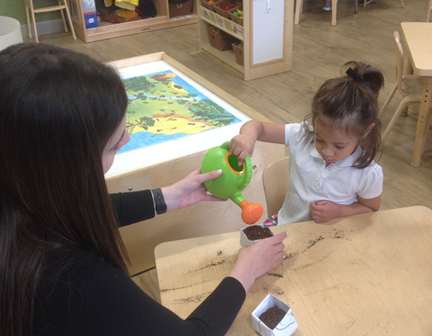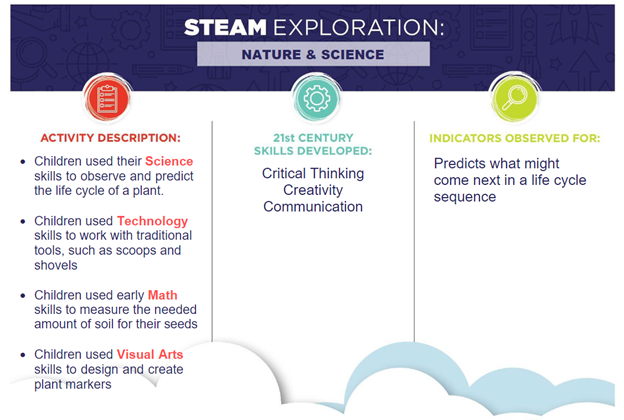- 866.222.0269
- Schedule a Tour
 Spring is officially in the air this week, so we’re embracing the start of a new season for our latest installment of STEAM Tuesday. Soon, in regions that endure a harsh winter, we’ll be seeing buds form on the trees and the fresh sprouts of perennial blooms poking up through our flowerbeds. Whether you have a green thumb or not, there is something special about watching new life take shape right before our eyes.
Spring is officially in the air this week, so we’re embracing the start of a new season for our latest installment of STEAM Tuesday. Soon, in regions that endure a harsh winter, we’ll be seeing buds form on the trees and the fresh sprouts of perennial blooms poking up through our flowerbeds. Whether you have a green thumb or not, there is something special about watching new life take shape right before our eyes.
“We need a watering can so they can grow!” ~Makai
“The seeds kind of look like teeth.” ~Claire
You can experience this magic at home as part of a STEAM-inspired activity with your children. Kids of all ages love any chance to dig around in the dirt and create something new, based on their efforts. They’ll engage all 5 senses while nourishing their love of hands-on experiments involving nature, science, the arts, and more. Let’s get started!
Planting Seeds Activity
Basic Materials:
- Seeds
- Small containers
- Potting soil or dirt
- Spoon, scoop, or shovel
- Watering can or dish with pour spout
- Magnifying glass
- Optional labels:
Popsicle sticks, paper, crayons, & glue
Step-by-Step Instructions:
- Start by selecting your seeds.
Use the 4Cs of 21st century learning to begin a conversation about the life cycle process. Encourage your child to Think Critically and develop their Scientific Skills by making predictions about how seeds grow. Use a magnifying glass to Communicate and make observations. Look closely to describe the texture, size, shape, etc. - Prepare your seed containers.
We suggest upcycling an old plastic bottle by having an adult cut it in half around the middle. You could also use an old egg carton. Poke holes in the bottom for draining. Talk about why you’re doing this to teach about the process. Ask what might happen if you add too much water or what might happen if your container had no holes. - Fill your containers with dirt!
The use of tools is widely considered a Technology skill. Have your child grab a spoon, scoop, or shovel for adding dirt. Utilize basic Math skills to measure the amount of soil used. Is it more or less than they expected? Count the number of seeds you’ll plant.
- Plant the seeds.
If you’re not dirty already, it’s an essential part of this step! Have your child use their fine motor skills to poke individual seeds down into the dirt. Careful not to go all the way to the bottom! What might need room to grow? Yes, the roots!
- Water your seeds.
Use the watering can to give your seeds a drink. Then, place them in a safe, sunny place and tend to them each day. When the soil is dry, give it another drink!
- Design seed markers.
Use Visual Arts and Creativity to create little signs, so you remember what types of seeds you planted. Write directly on a popsicle stick or design a little sign with scrap paper and crayons. Encourage your child to draw a picture of what the plant will look like! Glue it to the top of your stick.
This activity develops patience too! See how long it takes for a sprout to form, then a flower, then maybe even a veggie. Ask your child questions about each stage. What do you think will happen next? What might each stage look like? Collaboration is also a necessary 4Cs skill since this involves adult supervision and could be a great activity to share with a sibling, cousin, or friend.
BONUS: What about Engineering? Some plants require space to grow quite tall. If you choose to grow green beans, snap peas, or tomatoes, for instance, you’ll need to design a structure that will support the plant’s vertical need for space. For older children, this would involve building with wood, wire, or other materials.

